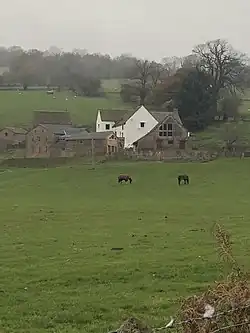| Llwyn-celyn Farmhouse | |
|---|---|
 The farmhouse in November 2018 with major renovations complete | |
| Type | Farmhouse |
| Location | Llanvihangel Crucorney, Monmouthshire |
| Coordinates | 51°53′26″N 3°00′17″W / 51.8905°N 3.0047°W |
| Built | Late medieval |
| Governing body | Landmark Trust |
Listed Building – Grade I | |
| Official name | Llwyn-celyn Farmhouse |
| Designated | 9 January 1956 |
| Reference no. | 1937 |
 Location of Llwyn-celyn Farmhouse in Monmouthshire | |
Llwyn-celyn Farmhouse, Llanvihangel Crucorney, Monmouthshire is a farmhouse of late medieval origins. It is a Grade I listed building.
History
The original farmhouse is a late-medieval hall house of c.1420.[1] In the late 17th century, both the hall, and the attached solar block were horizontally divided to create two-storeyed buildings.[2] An outhouse, with what was originally a free-standing kitchen, was linked to the main block in the 19th century, when the farm was part of the Llanthony Priory estate and owned by the poet Walter Savage Landor.[3]
There were subsequently almost no alterations made to the building for over 100 years.[2] By the early 21st century, the house was in a state of decay and, in 2014, ownership passed to the Landmark Trust. The Trust commenced a £4.5m restoration, which is largely complete as of November 2018.[4]
Architecture and description
The architectural historian John Newman describes the farmhouse as "quite exceptional, a complete late medieval hall house, all of stone."[5] Sir Cyril Fox and Lord Raglan, in the first of their three-volume study Monmouthshire Houses, give a construction date of c.1500, slightly later than that posited by Cadw and the Landmark Trust.[6] The roofs of the, now two-storeyed, hall and parlour show evidence of smoke-blackening, indicating that they were "originally open full-height."[5] Peter Smith, in his study Houses of the Welsh Countryside, notes the innovatory treatment of the hall and cross-passage.[7] The exterior is of Old Red Sandstone rubble.[3]
Notes
- ↑ "Llwyn Celyn reveals more secrets". Landmark Trust. Retrieved 18 December 2018.
- 1 2 "Llwyn-celyn Farmhouse, Crucorney, Monmouthshire". British Listed Buildings Online. Retrieved 11 April 2017.
- 1 2 Cadw. "Llwyn-celyn (Grade I) (1937)". National Historic Assets of Wales. Retrieved 16 March 2019.
- ↑ "Llwyn Celyn, Cwmyoy, Monmouthshire". Landmark Trust. Retrieved 18 December 2018.
- 1 2 Newman 2000, p. 209.
- ↑ Fox & Raglan 1994a, pp. 82–84.
- ↑ Smith 1975, p. 96.
References
- Fox, Cyril; Raglan, Lord (1994a). Medieval Houses. Monmouthshire Houses. Vol. 1. Cardiff: Merton Priory Press Ltd & The National Museum of Wales. ISBN 978-0-720-00396-3. OCLC 916186124.
- Newman, John (2000). Gwent/Monmouthshire. The Buildings of Wales. London: Penguin. ISBN 0-14-071053-1.
- Smith, Peter (1975). Houses of the Welsh Countryside. London: Her Majesty's Stationery Office. ISBN 0-11-700475-8. OCLC 868639211.